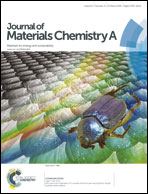Combinatorial optimization of spinel Co3−xMxO4 M = (Al, Ga, In) alloyed thin films prepared by ink jet printing: photoelectrochemical, optical, and structural properties†
Abstract
The photoelectrochemical, optical, and structural properties of semiconducting spinel oxide solid solutions and mixed phase thin films of Co3−xMxO4 [M = (Al, Ga, In)] are investigated as a function the Al : Ga : In alloying ratio and the total Co substitution amount, x. The highest photocurrent, and improved dark currents relative to unalloyed Co3O4 films, were measured from films with Al : Ga : In ratios of ∼1.5 : 1 : 1.9 at x = 0.4. Glancing angle XRD reveals a lattice expansion upon alloying when x ≥ 0.6 along with a general disordering of the crystal structure that appears to correlate with the In mole fraction since In has limited solubility in the spinel structure. However, an optimal balance of properties may be achieved, within the In solubility range, by the combined effects of the group IIIB elements resulting in higher cathodic photocurrents relative to unalloyed Co3O4 even though the optical absorption of the alloyed compositions is systematically reduced and blue shifted. SEM analysis reveals clear changes in film morphology exhibiting a smoother surface when x ≥ 0.6. This work demonstrates that combinatorial band engineering can help optimize the photoelectrochemical performance of Co3O4 by offsetting losses in optical absorption via improved carrier transport.


 Please wait while we load your content...
Please wait while we load your content...